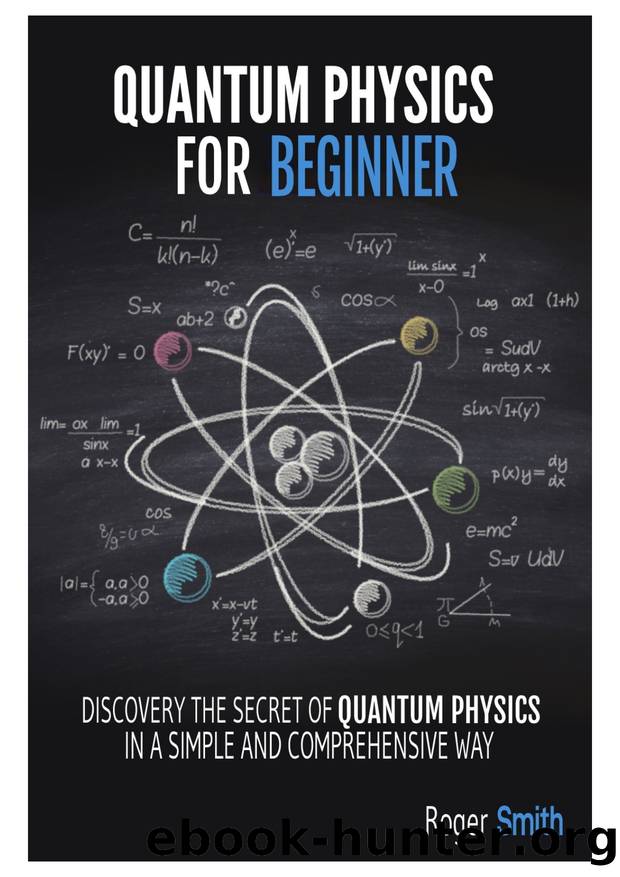Quantum Physics for Beginners: discover the secrets of quantum physics in a simple and comprehensive way by Smith Roger

Author:Smith, Roger [Smith, Roger]
Language: eng
Format: epub
Published: 2020-12-20T16:00:00+00:00
Chapter 5: Heisenbergâs Uncertainty Principle
Weâve all been uncertain at times. Do we want the chicken or the fish? Which movie do we want to see? Eventually, you make a decision, and the uncertainty is gone. But in order to understand the next concept weâre about to tackle, you need to think about being both certain, and uncertain at the same time. Heisenbergâs Uncertainty Principle, which he introduced to the world in 1927, aims to explain one of quantum mechanics' biggest problems- how can one predict where a particle will be at any given time, even with the knowledge of its momentum or previous position? First, letâs take a look at Heisenbergâs work that led him up to the Uncertainty Principle.
Heisenbergâs Beginnings in Physics
Werner Heisenberg was born in Germany to academic parents. His father was a professor of ancient languages and Greek philosophy, and young Werner loved to engage in philosophical discussions with his own teachers and peers. He spoke almost lovingly of the atom as a philosophical pursuit, which could only be reliably accounted for with mathematics. He would study under and with some of the other great scientific minds of his time, including Niels Bohr himself.
Heisenberg was also musically talented, a common thread among many of the pioneering physicists. His propensity for the piano led him to meet his future wife, Elizabeth, after a performance. She was also from an academic family and encouraged him throughout his career to push his theories and research to new heights of discovery. The physicist was also an avid outdoorsman, active in many roles with the German Scouts throughout his lifetime. He would often retreat to the mountains when he was thinking through an incredibly difficult physics or mathematical problem.
While he is mainly known today for his famous uncertainty principle, Heisenbergâs earliest major work was a collaboration borne from his doctoral thesis. In partnership with Max Born and Pascual Jordan, Heisenberg proposed a set of mathematical matrices that could be used to describe and predict the motion of atomic particles in relation to mechanical processes. Unfortunately for Heisenberg and his colleagues, they were in the Bohr camp of theoretical physics, which was slowly being phased out for the more progressive work of Einstein, Planck, Schrödinger, de Broglie. While classical physics and mathematics were still a foundation of the newer fields of quantum physics, quantum mechanics, and atomic studies, the disciplines were experiencing a rapidly widening gap in beliefs and principles.
While Heisenbergâs mechanical matrices were not universally accepted or utilized by the physics community, they werenât without merit. Part of the reason they fell by the wayside is that Bohrâs school was falling out of favor as being outdated. While this seems a little ridiculous given the speed at which new quantum discoveries were being made, Bohr and his contemporaries and students were firmly entrenched in the physical properties of the atom as a real, tangible object. While the Einstein camp was studying wave-particle duality, the Bohr camp was concerned with what they called discrete bundles- quantum particles traveling together in packets of energy.
Download
This site does not store any files on its server. We only index and link to content provided by other sites. Please contact the content providers to delete copyright contents if any and email us, we'll remove relevant links or contents immediately.
The Complete Stick Figure Physics Tutorials by Allen Sarah(7338)
Secrets of Antigravity Propulsion: Tesla, UFOs, and Classified Aerospace Technology by Ph.D. Paul A. Laviolette(5333)
Thing Explainer by Randall Munroe(3910)
The River of Consciousness by Oliver Sacks(3572)
The Order of Time by Carlo Rovelli(3162)
How To by Randall Munroe(3074)
A Brief History of Time by Stephen Hawking(2992)
I Live in the Future & Here's How It Works by Nick Bilton(2960)
What If?: Serious Scientific Answers to Absurd Hypothetical Questions by Randall Munroe(2668)
The Great Unknown by Marcus du Sautoy(2662)
Midnight in Chernobyl by Adam Higginbotham(2516)
Blockchain: Ultimate Step By Step Guide To Understanding Blockchain Technology, Bitcoin Creation, and the future of Money (Novice to Expert) by Keizer Söze(2467)
Networks: An Introduction by Newman Mark(2382)
The Meaning of it All by Richard Feynman(2319)
Easy Electronics by Charles Platt(2308)
The Tao of Physics by Fritjof Capra(2247)
Midnight in Chernobyl: The Untold Story of the World's Greatest Nuclear Disaster by Adam Higginbotham(2196)
When by Daniel H Pink(2098)
Introducing Relativity by Bruce Bassett(2097)
